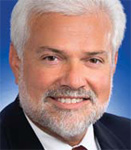Lilly's Approach To Discovery Via Collaboration

By Ed Miseta, Chief Editor, Clinical Leader
Being a large pharmaceutical company located in the Midwest has some advantages, but the location is still evolving as a recognized pharma or bio hub. Today’s drug development challenges are also more complex, and some cannot be solved by one company alone. That means pharma firms such as Eli Lilly and Company have to perform research without boundaries, so as to access the best innovators and thought leaders wherever they exist.
 Andy Dahlem, VP and COO of Lilly Research Labs, notes the company’s long history of success has been built on collaborating, specifically building relationships between internal scientists and the external world. Those relationships have helped, for example, with solving problems related to molecules in development. But having these relationships also provides access to individuals who might like to collaborate with Lilly on developing their own molecules.
Andy Dahlem, VP and COO of Lilly Research Labs, notes the company’s long history of success has been built on collaborating, specifically building relationships between internal scientists and the external world. Those relationships have helped, for example, with solving problems related to molecules in development. But having these relationships also provides access to individuals who might like to collaborate with Lilly on developing their own molecules.
“In exchange for that development opportunity, we offer much more than just financial remuneration,” notes Dahlem. “We offer true collaborations with our scientists in the development of molecules and the planning for bringing them forward. We believe that approach has been beneficial for all parties involved.”
Throughout its history, Lilly’s success has been contingent on its ability to both innovate internally and acquire molecules from external sources. About half the medicines Lilly has marketed to patients in the last two decades were developed via some form of external collaboration, extending from the earliest parts of the discovery effort through to the entire discovery and development process.
As a result of that history, Lilly now has a diverse set of long-term public/private partnerships in place, which the company views as a core part of its business. Scientists are given the time, access, and permission to build these relationships. Those collaborations that are built in the precompetitive space will provide both entities the opportunity to continue to work together as additional therapies are discovered.
BIG PHARMA PARTNERING WITH BIG PHARMA
Dahlem believes finding a treatment for diseases such as cancer and Alzheimer’s is akin to fighting a war. That means companies will increasingly find themselves seeking allies to help in the struggle. That also means Big Pharma companies will need to align resources with other Big Pharma companies. It is not unusual to see press releases announcing a Lilly collaboration with BMS or Merck on a combination therapy. For diseases such as cancer, if two large pharma companies each hold a piece of the puzzle, partnering may be the best option to save and prolong human lives.
“We are always looking for new and innovative ways to collaborate, particularly in the precompetitive space,” says Dahlem. “We locate potential partners, identify targets, and then accelerate the development of a single agent. We take those back to our labs and are off to an aggressive start as a result of the effort. This partnering can also take the form of combination therapies, where we partner with another pharma company possessing a molecule that we think might be effective in combination with ours.”
In his role as SVP for corporate business development at Lilly, Darren Carroll works with the teams responsible for all transactions, from the early stage of technology through to the latest collaborations, partnerships, mergers, and acquisitions. He notes the company was also the first to establish a separate office to manage all alliances.

"Resource allocation is a struggle for every pharma company that has an active and productive R&D engine."
Darren Carroll
SVP for Corporate Business Development at Lilly
Over the last five years, Lilly has been doing a lot more partnering with other large pharma companies. In those areas where Lilly has significant expertise, the company has increasingly been approached by experts in other companies hoping to develop a relationship. Two examples are a collaboration with Boehringer Ingelheim for the development and commercialization of several diabetes medicines and an agreement with Pfizer to codevelop a nerve growth factor inhibitor molecule that is the first in a new class of potential pain medicines. More recently, the company entered into a collaboration agreement with AstraZeneca on a BACE (beta secretase cleaving enzyme) inhibitor, which is in Phase 2 development for Alzheimer’s disease.
According to Carroll, Lilly will focus its collaboration and external innovation efforts on five therapeutic areas. Three are core therapeutic areas for Lilly: diabetes, oncology, and neurodegeneration. The other two are emerging areas in which Lilly has molecules in the pipeline: immunology and pain. How the molecules in those emerging areas progress will determine how aggressively the company will seek external innovation to supplement its efforts.
“Resource allocation is a struggle for every pharma company that has an active and productive R&D engine,” he says. “It’s our own capabilities in science, in fact, that are key to helping us identify external innovation opportunities, as well as how to best shape them.”
“The goal of these collaborations, our goal, is to improve the lives of patients,” says Dahlem. “Sometimes that will mean taking a Lilly drug, other times it will mean taking another company’s medicine. But sometimes the best option for the patient is taking two medicines produced by different companies. Many of these collaborations occur in the oncology space, and what we need to do is determine whether or not there are synergies that can be accrued by taking two agents in combination with each other. The only way we can determine that is by having scientists from both companies working together.”
ALIGNMENT OF STRATEGIES AND CROs IS VITAL
Most large pharma companies have efficient infrastructures in place that emphasize quality and patient safety in their operations. But as you might expect, bringing the two companies together to collaborate on a project is not an easy process. Knowing what issues might arise, and preparing for them ahead of time, will make for a smoother collaboration.
“One of the most important things you need to worry about is making sure you’re strategically aligned on how the combination of your medicines will benefit the patient,” says Carroll. “It is important to determine if your research programs can work together in a complementary fashion. Determining what tumors are of interest to each company should be an integral part of that process, but you must also ensure that both companies are pursuing the same end goal.”
Determining the effectiveness of a combination therapy requires additional research to determine if the two medicines together will still be as safe and effective as they are individually. This will entail additional data generation and investment. There will also be different approaches to development that have to be considered. Those approaches will determine how companies will begin to explore the level of proof necessary to make the next series of investments.
“One company might want to perform smaller, exploratory studies before making a larger investment, while another might prefer to jump right in,” notes Carroll. “I don’t think too many companies will take a one-size-fits-all strategy approach. You have to make sure the two companies’ philosophies align.”
Another challenge has to do with different CROs being used by each company. One solution might be to use two or more CROs to perform different aspects of the clinical study. For example, one CRO may recruit and treat patients, while the other performs the clinical laboratory analysis. “The synthesis of the information is often done by the sponsor,” notes Carroll. “In our experience, it is more likely that the collaborating companies would prefer to continue to keep working with multiple CROs on specific components of the study, where each CRO has unique qualifications or capabilities, than to select one over the other.”
PROJECT AND STEERING TEAMS DRIVE DECISIONS
Another action that carries a high degree of importance when partnering with companies of any size is establishing, early on in the process, how difficult decisions will be made. When an impasse is reached in a decision-making process, such as choosing a CRO, it is best to leave the decision up to a joint steering committee. There should be agreement on who gives input and who will be on the committee and, when there is an impasse, how the final decision will be made.
Generally there is a project team that drives the decision making within the collaboration, and it is made up of individuals from functional areas such as quality, legal, and regulatory. That team makes decisions on how a trial should be run. If two different perspectives arise and a decision has to be made at a higher level, that is when the joint steering committee would be engaged. Members of that committee would generally be senior leaders within the organizations.

"We are always looking for new and innovative ways to collaborate, particularly in the precompetitive space."
Andy Dahlem
VP and COO of Lilly Research Labs
Any partnering decision will have an impact on numerous functional areas (quality, regulatory, supply chain) within a company, so be sure to keep those areas involved in the partnering process. Lilly has an internal system called Linkage Hub to ensure everyone impacted by a collaboration is kept informed. Through the Linkage Hub collaborative, all pertinent documents are shared with representatives of every key function, geography, and business unit within the company in a timely fashion. These knowledgeable representatives serve as key communicators between project teams and functions and ensure alignment and collaborations occur effectively.
Linkage Hub is jointly run between the teams under Dahlem and Carroll. “We have both scientific and business leadership running Linkage Hub to ensure we have the maximum input possible,” notes Dahlem. “With these types of deals, we are well aware that the devil is in the details. We want to maintain a project team that is paying attention to the details and quickly driving efforts through to completion. Linkage Hub is made up of the individuals accountable to ensure that happens on a very reliable and particular basis.”
Finally, continuous improvement is important to Lilly in refining its collaboration efforts. To continually improve, Lilly employs partner surveys that assess how the company is performing on a number of partnership factors. “I think this is something that differentiates us from some of our peers,” says Dahlem. “We report the feedback and findings in a spider-web diagram. We look at the areas where we agree and disagree, and then we work to make improvements. This has been an effective tool for us in the development and implementation of strategic alliances.”
The spider diagram has three areas of focus: cultural fit, strategic fit, and operation fit. The cultural category looks at knowledge management and flexibility. Strategic fit examines commitment, strategy, and trust/fairness. Operational fit is the most encompassing of the three areas and examines communication, conflict management, decision making, leadership, performance management, roles, skills/competence, and team coordination.
Dahlem notes as a result of these surveys, Lilly can quickly see where they agree or disagree with a partner on performance of the collaboration. The company can also identify root causes to improve performance. “Effective communication is at the core of strong collaborations, and these spider diagrams give us direct feedback to aid communication at all levels,” he says. “It’s this feedback that will enable us to continue to be a strong collaborator well into the future.”
Collaborations Will Drive Oncology Research
Sue Mahony, SVP of Eli Lilly and president of Lilly Oncology, expects Big Pharma collaborations in particular will be critical for companies looking to stay on top of innovation in key therapeutic areas, for instance, oncology. She notes combination therapies will be key to addressing tumor heterogeneity and the inevitable resistance that is likely to develop to even the most promising new tailored therapies.
Last year Lilly announced a collaboration with Immunocore that gives Lilly exclusive access to a new biology that includes three distinct targets. In 2014 the company also expanded its existing collaboration with Zymeworks to develop potential cancer immunotherapies. And earlier this year, Lilly announced it will collaborate with Innovent Biologics to support the development and potential commercialization of at least three cancer treatments over the next decade.
“Oncology collaborations are designed to give us more information about the potential of combination therapies, which will be instrumental to the future of cancer care,” she states. “Cancer is not one disease, but rather more than 200 diseases, all of which have different causes and treatments. As such, cancer will remain a complex and difficult-to-treat disease area for many years to come. We don’t expect that a single technology will modify this situation in the next decade.”
